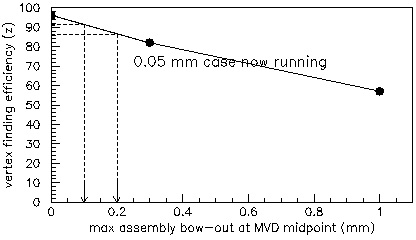
|
![[Up]](arrow.marble.up.gif)
|
![[Next]](arrow.marble.right.gif)
Previous page
| Up to the index
| Next page
| |

|
![[Up]](arrow.marble.up.gif)
|
![[Next]](arrow.marble.right.gif)
Previous page
| Up to the index
| Next page
| |
Under the influence of humidity increases, rohacell tends to expand. Since the cages are restrained by the glued-on silicon panels, and not all faces have silicon on them, there is a tendency of the entire 12-cage assembly to bow out in the direction of the non-populated faces (up and out).
In these runs this effect was simulated by placing the sensitive silicon volumes at different radii and also tilting them slightly so they form an arc in the r-z plane. The inner and outer silicon were displaced the same amount, so that their relative spacing was not affected. Because of the Geant geometry structure, each 60-degree sector (for now) gets the same bowing.

 |
This plot summarizes the vertex-finding efficiency as a function of
maximum bow-out of the 12-cage assembly. Dotted lines indicate a 5% and 10% losses in efficiency, for maximum bowing of 0.1 and 0.2 mm, respectively. |